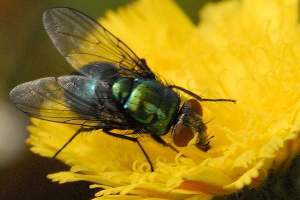Reproduction
The Life History:
The Life cycle of Lucilia sericata consists of
four stages that include adult, egg, larva, and pupa. Each
female can lay 2000-3000 eggs in 9-10 batches within only 3
weeks! The amount of eggs that a female can
develop depends
greatly on the temperature. Eggs are usually laid on cavities
and crevices of moist decaying organisms. Lucilia sericata
like to lay their eggs in an area that is usually exposed to
light.
Check out this
Youtube video of a fly laying
eggs!
Maggots then hatch from the eggs and attach themselves to
an organism that it is on. After about 4-9 days the maggots are
done with development. The maggots will then go into a pre-pupa
stage where they will burrow themselves into soil and then
pupate into a pupa. In this stage, the maggot is encompassed in a hardened
shell where it will molt and gain wings. They are motionless, do
not eat, and cannot protect themselves. An average pupa stage
will last about 7 days. Some flies can stay in the pupa stage
for up to 115 days because of low soil temperatures.
 Adult flies will then escape from their pupa and journey
above the surface of the soil. Take a look at this Youtube
video of flies emerging from the
pupa! At first the fly will be soft and
not contain its bright green color. It will take the body of the
fly 48 hours to harden, which it will then display, color and
finally
have fully functional wings. Mating activity will then occur
anywhere from 3-8 days after emergence. Then the life cycle will
start all over again!
Adult flies will then escape from their pupa and journey
above the surface of the soil. Take a look at this Youtube
video of flies emerging from the
pupa! At first the fly will be soft and
not contain its bright green color. It will take the body of the
fly 48 hours to harden, which it will then display, color and
finally
have fully functional wings. Mating activity will then occur
anywhere from 3-8 days after emergence. Then the life cycle will
start all over again!
Now we will see how Lucilia sericata has
interactions with other
organisms.
Y